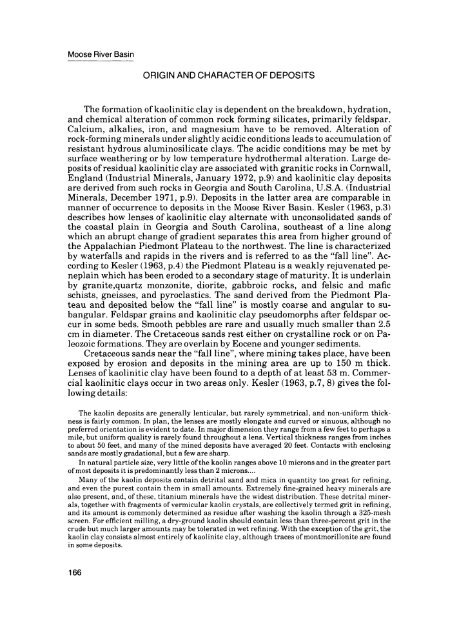Moose River Basin: geology and mineral potential - Geology Ontario
Moose River Basin: geology and mineral potential - Geology Ontario
Moose River Basin: geology and mineral potential - Geology Ontario
You also want an ePaper? Increase the reach of your titles
YUMPU automatically turns print PDFs into web optimized ePapers that Google loves.
<strong>Moose</strong> <strong>River</strong> <strong>Basin</strong><br />
ORIGIN AND CHARACTER OF DEPOSITS<br />
The formation of kaolinitic clay is dependent on the breakdown, hydration,<br />
<strong>and</strong> chemical alteration of common rock forming silicates, primarily feldspar.<br />
Calcium, alkalies, iron, <strong>and</strong> magnesium have to be removed. Alteration of<br />
rock-forming <strong>mineral</strong>s under slightly acidic conditions leads to accumulation of<br />
resistant hydrous aluminosilicate clays. The acidic conditions may be met by<br />
surface weathering or by low temperature hydrothermal alteration. Large de<br />
posits of residual kaolinitic clay are associated with granitic rocks in Cornwall,<br />
Engl<strong>and</strong> (Industrial Minerals, January 1972, p.9) <strong>and</strong> kaolinitic clay deposits<br />
are derived from such rocks in Georgia <strong>and</strong> South Carolina, U.S.A. (Industrial<br />
Minerals, December 1971, p.9). Deposits in the latter area are comparable in<br />
manner of occurrence to deposits in the <strong>Moose</strong> <strong>River</strong> <strong>Basin</strong>. Kesler (1963, p.3)<br />
describes how lenses of kaolinitic clay alternate with unconsolidated s<strong>and</strong>s of<br />
the coastal plain in Georgia <strong>and</strong> South Carolina, southeast of a line along<br />
which an abrupt change of gradient separates this area from higher ground of<br />
the Appalachian Piedmont Plateau to the northwest. The line is characterized<br />
by waterfalls <strong>and</strong> rapids in the rivers <strong>and</strong> is referred to as the "fall line". Ac<br />
cording to Kesler (1963, p.4) the Piedmont Plateau is a weakly rejuvenated pe<br />
neplain which has been eroded to a secondary stage of maturity. It is underlain<br />
by granite,quartz monzonite, diorite, gabbroic rocks, <strong>and</strong> felsic <strong>and</strong> mafic<br />
schists, gneisses, <strong>and</strong> pyroclastics. The s<strong>and</strong> derived from the Piedmont Pla<br />
teau <strong>and</strong> deposited below the "fall line" is mostly coarse <strong>and</strong> angular to su<br />
bangular. Feldspar grains <strong>and</strong> kaolinitic clay pseudomorphs after feldspar oc<br />
cur in some beds. Smooth pebbles are rare <strong>and</strong> usually much smaller than 2.5<br />
cm in diameter. The Cretaceous s<strong>and</strong>s rest either on crystalline rock or on Pa<br />
leozoic formations. They are overlain by Eocene <strong>and</strong> younger sediments.<br />
Cretaceous s<strong>and</strong>s near the "fall line", where mining takes place, have been<br />
exposed by erosion <strong>and</strong> deposits in the mining area are up to 150 m thick.<br />
Lenses of kaolinitic clay have been found to a depth of at least 53 m. Commer<br />
cial kaolinitic clays occur in two areas only. Kesler (1963, p.7, 8) gives the fol<br />
lowing details:<br />
The kaolin deposits are generally lenticular, but rarely symmetrical, <strong>and</strong> non-uniform thick<br />
ness is fairly common. In plan, the lenses are mostly elongate <strong>and</strong> curved or sinuous, although no<br />
preferred orientation is evident to date. In major dimension they range from a few feet to perhaps a<br />
mile, but uniform quality is rarely found throughout a lens. Vertical thickness ranges from inches<br />
to about 50 feet, <strong>and</strong> many of the mined deposits have averaged 20 feet. Contacts with enclosing<br />
s<strong>and</strong>s are mostly gradational, but a few are sharp.<br />
In natural particle size, very little of the kaolin ranges above 10 microns <strong>and</strong> in the greater part<br />
of most deposits it is predominantly less than 2 microns....<br />
Many of the kaolin deposits contain detrital s<strong>and</strong> <strong>and</strong> mica in quantity too great for refining,<br />
<strong>and</strong> even the purest contain them in small amounts. Extremely fine-grained heavy <strong>mineral</strong>s are<br />
also present, <strong>and</strong>, of these, titanium <strong>mineral</strong>s have the widest distribution. These detrital miner<br />
als, together with fragments of vermicular kaolin crystals, are collectively termed grit in refining,<br />
<strong>and</strong> its amount is commonly determined as residue after washing the kaolin through a 325-mesh<br />
screen. For efficient milling, a dry-ground kaolin should contain less than three-percent grit in the<br />
crude but much larger amounts may be tolerated in wet refining. With the exception of the grit, the<br />
kaolin clay consists almost entirely of kaolinite clay, although traces of montmorillonite are found<br />
in some deposits.<br />
166

















